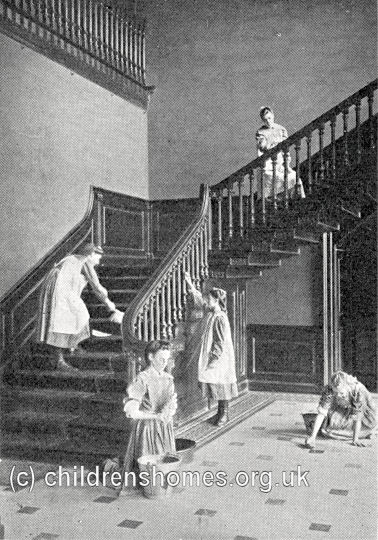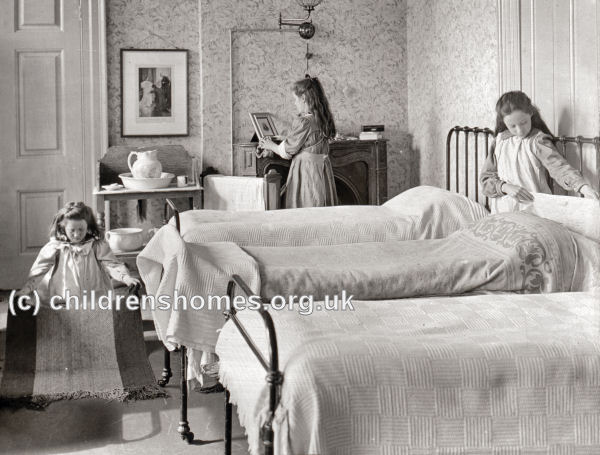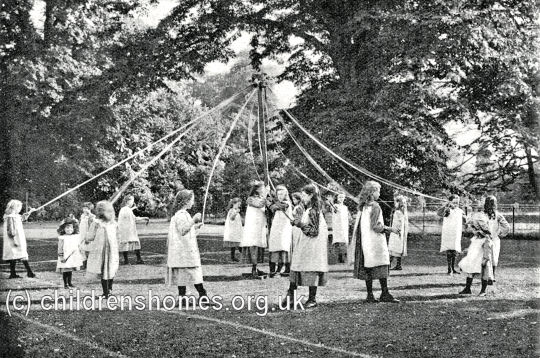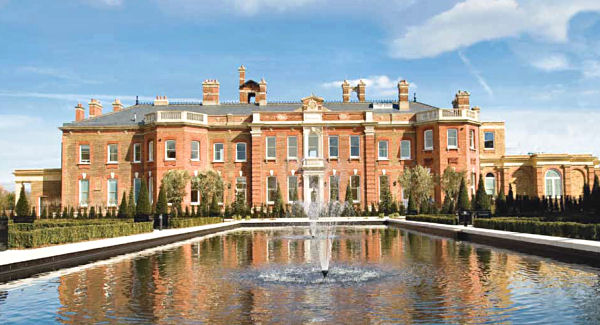London School Board / LCC Industrial School for Girls, Gordon House, Isleworth, Middlesex
In 1897, the London School Board opened its first Industrial School for girls at Gordon House, Isleworth. The Board had previously sent girls to various Industrial Schools with which it had agreements. That practice continued to be adopted in many cases, but the younger girls were now generally sent to Gordon House.
Gordon House, a large mansion with extensive grounds on the banks of the Thames, had been given by King William IV to Augusta Fitzclarence, his daughter by the actress Mrs Dorothea Jordan. It subsequently became the home of Lord Frederick Gordon. The Board was fortunate in acquiring the house and its grounds for the just £7,000, much less than a comparable site and new building would have cost. On December 1st, 1897, the property was formally certified to begin operation, with accommodation for 50 girls. The first superintendent resigned in March, 1898, and charge was taken temporarily by Mrs Hartland, matron of the Brentwood Industrial School. Mrs Egerton was appointed superintendent on July 4th, 1898, but resigned before the end of the year and was replaced by Miss A.E. Challenger.
In 1900, a cottage was built in the grounds to provide sleeping accommodation for an additional 20 inmates. On December 3rd, 1900, the official capacity of the School was increased to 70 places. The girls in the cottage had their lessons and meals in the main house.
As well as classroom lessons, the girls received instruction in sewing and knitting. With the exception of the youngest, the girls could make and repair their own clothes. They also helped with the general house and kitchen work, washing, and waiting at table. The older ones had special lessons in cookery and laundry work. As well as being preparing girls for domestic service, the School was encouraged to place any with particular aptitude as pupil teachers.

Gordon House Industrial School for Girls cookery lesson, Isleworth, early 1900s. © Peter Higginbotham

Gordon House Industrial School for Girls housework, Isleworth, early 1900s. © Peter Higginbotham

Gordon House Industrial School for Girls bedroom tidying, Isleworth, early 1900s. © Peter Higginbotham
The School's large grounds provided plenty of space for play. Regular sessions also took place in Swedish drill and in performing marching and running exercises.

Gordon House Industrial School for Girls maypole, Isleworth, early 1900s. © Peter Higginbotham
On May 1st, 1904, control of the School passed to the London County Council who took over the work of the London School Board on that date. On November 26th of the same year, Miss Challenger was succeeded as matron by Miss M.L. Croisdale.
A mark system was in operation at the School whereby good conduct was rewarded with small monetary rewards. In 1906, it was noted that during the summer twenty of the girls attended a swimming bath for instruction. The girls were taken on weekly or monthly walks and on occasional shopping expeditions. Small garden plots had been created for them to cultivate.

Gordon House Industrial School for Girls getting-up time, Isleworth, early 1900s. © Peter Higginbotham
Due to a decline in the number of admissions, the School was formally closed on August 2nd, 1922.
The building was subsequently occupied by the Royal Naval Female School and later by Maria Grey College. In more recent years, the property was acquired by Brunel University, then sold for for renovation as a luxury home.

Former Gordon House Industrial School for Girls, Isleworth, early 1900s. © Peter Higginbotham
Records
Note: many repositories impose a closure period of up to 100 years for records identifying individuals. Before travelling a long distance, always check that the records you want to consult will be available.
- The
Ancestry UK
website has two collections of London workhouse records (both name searchable):
- The Find My Past website has workhouse / poor law records for Westminster.
- London Metropolitan Archives, 40 Northampton Road, London EC1R OHB. Holdings include: Registers of children (1897-1922); Committee minutes (1904-1922).
Bibliography
- Higginbotham, Peter Children's Homes: A History of Institutional Care for Britain's Young (2017, Pen & Sword)
- Mahood, Linda Policing Gender, Class and Family: Britain, 1850-1940 (1995, Univeristy of Alberta Press)
- Prahms, Wendy Newcastle Ragged and Industrial School (2006, The History Press)
Links
- None identified at present.
Except where indicated, this page () © Peter Higginbotham. Contents may not be reproduced without permission.


